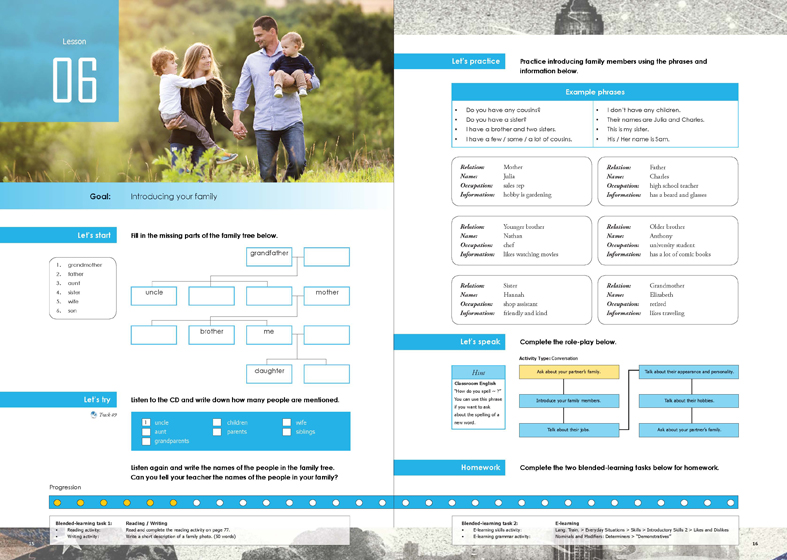
Manuals > General English > Rosetta Stone Advantage > Beginner - Book 1 > Lesson 6
< Previous Lesson | Next Lesson >

By the end of the lesson, the student should be able to introduce their family members,
Communication strategies:
The student should be able to able to greet someone and introduce themselves by following the 3 steps below:
1) State which family members you have.
2) State what their names are.
3) Share some information about them.
e.g. I have a sister. Her name is Alice. She is a sales rep. She likes gardening.
Words and rules:
The student should be able to use possessive adjectives
e.g. Her name is Alice.
The student should be able to use "have" to indicate family members exist e.g. I have a brother.
The student should be able to name different family relationships. e.g. brother
The student should be able to ask about plural and singular family members e.g. Do you have a son? / Do you have any kids?
Appropriateness:
Register: When talking to a friend about their family a casual register is usually used.
Social rules: We usually don't ask someone we have just met about their marital status. e.g. Are you married? / Do you have a wife?
Track #9
Hello, I’m Steve. I’m married. My wife’s name is Sharon. We have two
kids: Peter and Alice. I have one brother and one sister. My brother’s
name is Michael and my sister’s name is Chloe. My mother and
father are called Audrey and John. I have one uncle and one aunt.
Their names are Jim and Kate. I also have a grandmother and a
grandfather. Their names are Elizabeth and Benjamin.
Because the lesson touches on the topic of family, you are welcome to introduce some of the following vocabulary if you like.
1) a husband (n)
2) a niece (n)
3) a nephew (n)
4) a great-grandmother (n)
5) a great-grandson (n)
6) a kid (n)
7) a child (n)
8) a cousin (n)
9) a brother-in-law (n)
10) a sister-in-law (n)
Option 1:
Difficulty ★
Purpose: To assist the student with visualizing the different family relationships
Type: Drawing - Realia
Method: On a separate sheet of paper, the student draws a family tree for their family.
This can be used at different points in the lesson e.g. checking to make sure they
understand the different family relationships, and for the final role-play.
Option 2:
Difficulty ★★
Purpose: To elicit vocabulary from the student
Type: Warm up - Picture speculation
Method: Have the student look at the picture on the top of the page, and have them guess
the different relationships. e.g. I think this is her dad. I think this person is her son.
Option 3:
Difficulty ★★★
Purpose: To practice asking common questions about someone’s family
Type: Interview
Method: Have the student interview you about your family and ask you at least 5 questions.
Naruhodo Point
Saying “I have three families” is very different to saying “I have three family members”
Extra questions you might like to ask in the lesson
- Do you have a big family?
- How many people are there in your family?
- Do you have a son?
- Do you have any kids?
- What does your dad do?
- What’s your sister’s name?
- How old is your brother?
- How tall is your brother?
A speaking hint you might like to use
AAA = Answer Add Ask
> Feel free to use this speaking hint in the “Let’s Practice” / “Let’s Speak” sections of the lesson. This is particularly useful when describing someone’s personality.
Question: Do you have a brother?
Answer: Yes.
Add: His name is Ben. He is a teacher.
Ask: Do you have a brother?
Let’s start
Fill in the missing parts of the family tree below.
Top line (L>R)
grandmother
Second line (L>R)
aunt / father
Third line (L>R)
sister / wife
Fourth line (L>R)
son
Let’s try
Listen to the CD and write down how many people are mentioned.
Track #9
Hello, I’m Steve. I’m married. My wife’s name is Sharon. We have two kids: Peter and Alice. I have one brother and one sister. My brother’s name is Michael and my sister’s name is Chloe. My mother and
father are called Audrey and John. I have one uncle and one aunt. Their names are Jim and Kate. I also have a grandmother and a grandfather. Their names are Elizabeth and Benjamin.
uncle = 1
aunt = 1
grandparents = 2
children = 2
parents = 2
Wife = 1
siblings = 2
Listen again and write the names of the people in the family tree.
Grandmother = Elizabeth
Grandfather = Benjamin
Uncle = Jim
Aunt = Kate
Father = Audrey
Mother = John
Sister = Chloe
Brother = Michael
Me = Steve
Wife = Sharon
Son = Peter
Daughter = Alice
A) Can you tell your teacher the names of the people in your family?
B) My father’s name is Tetsuo, my mother’s name is Minami. My brother’s name is Kenji.
Let’s practice
Practice introducing family members using the phrases and information below.
Relation: Mother
Name: Julia
Occupation: sales rep
Information: hobby is gardening
My mother’s name is Julia. She is a sales rep. Her hobby is gardening.
Let’s speak
Introduce your family to your teacher.
A) Hi Sam. Tell me about your family.
B) OK. There are four people in my family - me, my brother, my father and my mother. My brother is a banker. He works in Sydney. My father is a salesman. He works for a big company. My mother is a doctor. She works at the local hospital. My brother and father are both tall, but my mother is short. My brother and father both love sports. They like soccer and baseball. My mom likes baseball too. How about you? Do you have a big family?